Matthew Murrie's Blog, page 15
May 14, 2020
Curiosity, COVID-19, and the Unknown
How many times have you been faced with the unknown? A hundred, a thousand… maybe a million unknowns in your lifetime? What if you are faced with many unknowns everyday? Will today be a good day or a bad day? Will people like me? What do carnitas taste like? Will it rain today? How much?
Congratulations! Regardless of how today goes, or yesterday went, or tomorrow will be, you have been overcoming thousands and thousands of unknowns throughout your life. And for as long as you keep living, the only certainty is the unknown.
The world is working hard to overcome the disease and its impact on everyone’s life. Like past viral outbreaks, scientists, doctors, and others will find a way to cure people and help us get back to our lives before the COVID 19 outbreak.
Until that unknown day comes, what if you spend your time knowing and doing more? How? What if it's as easy as going from A-Z? What if the most effective way to turn an unknown into a known is to ask more questions and share more thoughts?
Discoveries can’t be made without knowing where to look. Answers can’t be found without the right questions being asked. That’s where curiosity and curiosity based learning comes in. What if we're all better off when we practice using curiosity to look at COVID-19 and other unknowns as something to know rather than fear?
If you're curious how and where you can get curious about COVID-19 and other unknowns, you can start exploring COVID-19 A-Z. Or, if you're looking for a little more action behind your discovering, you can start Conquering COVID-19 with 17 SDGs. Once you're done saving the World with your curiosity, visit the Library of Curiosity where you can let your curiosity lead your learning with an ever-growing number of lessons, activities, and discoveries to help you overcome your fear of the unknown with an enthusiasm you've never known.
What If Robots Looked Like Humans?
What if robots looked and acted just like humans and animals? How would your feelings about them change? Let your curiosity lead your learning with this curiosity based learning from The Book Of What If...?
https://www.youtube.com/watch?v=1xdN6LCxPhA&feature=youtu.be
What if robots looked like humans and animals?
What: What would you do if you discovered someone you knew was actually a robot? Write a text to them to tell them how you feel about this discovery.
Who: Out of everyone you know, who do you think might actually be a robot? Write a diary entry sharing your thoughts why?
How: How could you test if someone where a robot or human? Write out the instructions to a test to use to test is someone is a human or robot?
When: Do you think the first robot will become the President of a country? Create a campaign poster for a robot running for President.
Where: Do you think robots who look like humans would live and work? Make an advertisement targeted for robots looking for work or a place to live.
Why: Why do you think robots are necessary for humans? Right a short poem about a child and their robot.
Huh?: What if you found out that you are a robot? Who would be the first person you would talk to? Write a short letter sharing your news with them.
Wow!: Why would zoos of robots that look and act exactly like "real" animals be better to visit than the zoos we have today? What are the top three things you would like to see replaced by robots? Give a sentence reason why for each.
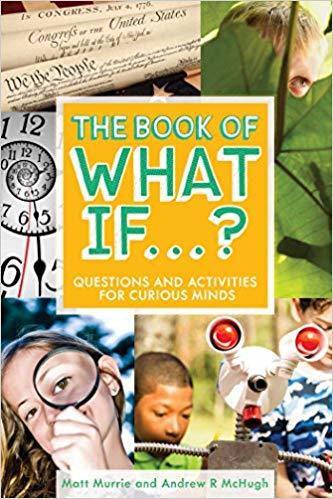
May 13, 2020
Manifest Curiosity Part VIII: Discovery Learning (a.k.a. Leafy Sea Dragon)
This post is the first in a series of posts from Manifest Curiosity that details they hows, whens, and whys of Curiosity Based Learning.
Discovery Learning (a.k.a. Leafy Sea Dragon)
Discovery Learning is a four-step process that flips the entire learning experience when learning about something new. Rather than telling students they are going to learn about something and then tested to see how much of their learning they can remember and communicate on demand, students start by being asked to wonder.
For example: what if there were a creature called a leafy sea dragon? Ask your students and then, ask them to draw what they think it would look like. Next, ask them to draw another leafy sea dragon, but this time with a few details and instructions. After they have used their curiosity and creativity to create two detailed creatures, share an image of what a leafy sea dragon actually looks like. Lastly, share with the students all of the information you would like for them to know about it.
Below is an example of this process with a Leafy Sea Dragon. This process can be used with anything from animals to historical events, chemical processes, or whatever students and curious minds need to learn for any subject and any level.
Discovery Learning Example Step 1:
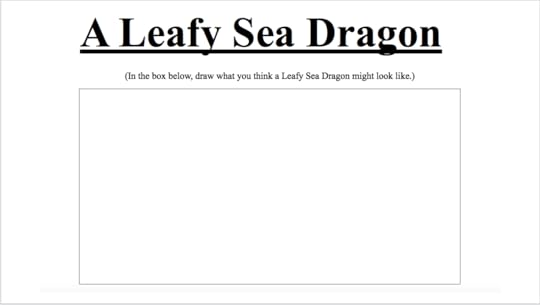
Discovery Learning Example Step 2:
The leafy sea dragon has a head that looks like a horse because it is a kind of seahorse. Its snout is much thinner and longer than a horse’s. It has a pectoral fin on its back near its head and a dorsal fin near its tail. Both fins are transparent and nearly invisible. The leafy sea dragon has 10-15 bony rings that surround its body and long, sharp spines that run along its back. The leafy sea dragon has 18-20 skin filaments hanging off of its head, body, and tail that look like blades of seaweed. Its color changes from shades of yellow, brown, and green depending on its diet, location, and level of stress.
(Now, using the description above, try drawing the Leafy Sea Dragon again.)

Discovery Learning Example Step 3:
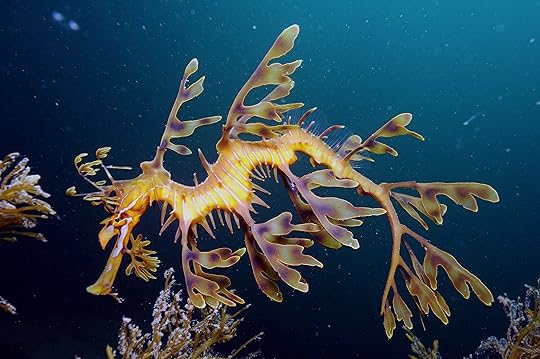
Photo Credit: James Rosindell, licensed by CC BY-SA 4.0
Discovery Learning Example Step 4:
Facts about the leafy sea dragon
Although a close relative of the seahorse, the leafy sea dragon is much larger. It can grow to over 14 inches (35cm) long.
The male leafy sea dragon carries up to 250 bright, pink eggs until they are hatched. Instead of carrying them in a pouch like most seahorses, the leafy sea dragon carries the eggs on the underside of its tail.
The “leaves” on the leafy sea dragon are not used for swimming; they serve only as camouflage to hide it.
The body of a leafy sea dragon is so rigid that it does not appear to move; its movements are controlled by the tiny fins on top of its head to steer it and its dorsal fins to propel it.
Everyday, the leafy sea dragon slurps thousands of microscopic, shrimp-like animals for its meals.
The leafy sea dragon has no known predators. Several of its characteristics keep predators away: it has highly developed camouflage, it has very sharp spines on its back, and it has very little meat on its body.
The leafy sea dragons are only found off the southern coast of Australia in kelp, seagrass, and boulders at depths up to 150 feet (50m).

Stay Curious with Manifest Curiosity Part IX: Curiosity Q&A
Curiosity Based Learning
May 12, 2020
Conquering COVID-19 with 17 SDGs: #2 Zero Hunger
What if you use your curiosity to help conquer COVID-19 and 17 SDGs? Up next? Sustainable Development Goal #2: Zero Hunger
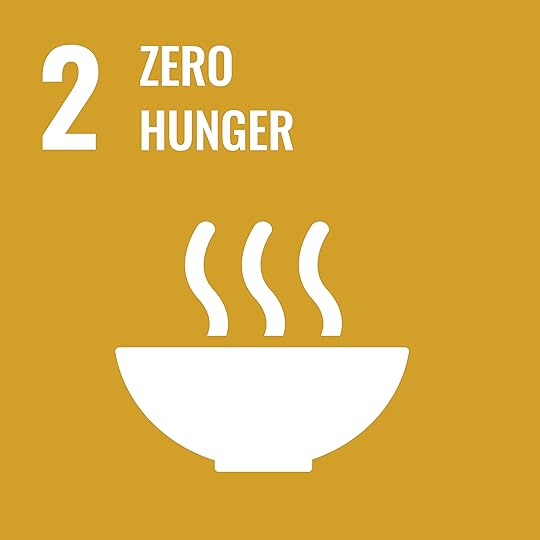
What: The goal is to end hunger by everyone on the planet having access to enough safe and nutritious food to feed them all year.
Who: This goal specifically focuses on helping hungry people in vulnerable situations like infants and people living in poverty.
How: One of the ways this goal seeks to achieve ending the world of hunger is to. "...double the agricultural productivity and incomes of small-scale food producers, in particular women, indigenous peoples, family farmers, pastoralists and fishers..."(Source)
When: In the most recent count in 2017, there were an estimated 821 malnourished people living on our planet.
Where: In large parts of the developing world, 80% of their food comes from small farms.
Why: Hunger matters both to individuals and the human species; when someone is hungry or malnourished, it is difficult for them to provide for their families or contribute to their communities, increasing the challenges of achieving the goals like education and health.
Huh?: According the the United Nations, "If women farmers had the same access to resources as men, the number of hungry in the world could be reduced by up to 150 million." Why do you think this is true?
Wow!: Think about the last time you were really hungry. How did you feel? How was your attitude? How did you feel about doing work or speaking with other people? Now, imagine a world where nobody ever felt that way. Pretty cool, huh?
How SDG #1, Zero Hunger connects to COVID-19:
Hungry and malnourished people can be more susceptible to getting sick or catching diseases like COVID-19; access to healthy food is critical to staying healthy during quarantine, and gives our bodies better chances of fighting off viruses.
Using Curiosity to connect COVID-19 with SDG #2 Zero Hunger:
What if, everybody viewed food as medicine? What if, instead of calling it "food" we called it "medicine"? How would that affect what you eat? How would that change how you think about people without it?
Call-to-action challenge to take on ending hunger and COVID-19: Small-food farms is one of the ways people are solving working to end the world of hunger; during COVID-19 quarantine, many people took the opportunity to start small gardens in or around their homes. What if you start a garden (or a farm!): What foods would you start growing at home if you could start a garden? Are there any foods you could grow that could help you or others survive COVID-19 or other viruses? Can you grow any foods you could give away to help end hunger?
You can also take the COVID-19 A-Z Challenge and if you want to take your curiosity about understanding and taking actions on COVID-19 to the extreme, download the COVID-19 A-Z eBook for more discovering, doing, and making the world a better planet.
Keep conquering COVID-19 with the SDGs with SDG #... coming soon!

Curiosity Based Learning
What? to Wow!
COVID-19 A-Z
Sustainable Development Goals (SDGs)
May 10, 2020
Conquering COVID-19 with 17 SDGs: #1 No Poverty
Sustainable Development Goal #1 calls for solutions to end poverty everywhere on the planet. Use your curiosity to deepen your understanding and drive your actions to do something about it
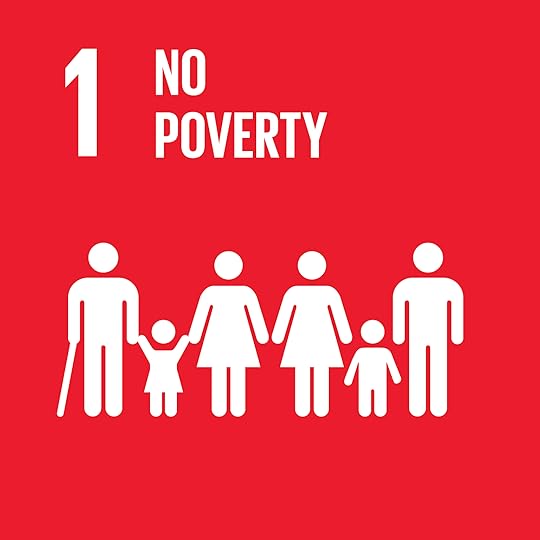
What is poverty? Poverty is when people don't have enough money or resources to make their most basic needs, like food and shelter; extreme poverty is defined as individuals earning less than $1.90 USD a day.
Who does poverty affect? Extreme poverty affected 10% of our world's population, or about 700 million people in 2015; in 2018, that number was down to 8.6%, but current projections still show us coming short of reaching 0% by 2030.
How does much would it cost to solve the problem of poverty? According to the economist, Jeffery Sachs, it would cost about $175 billion USD a year for 20 years; while that sounds like a lot, it is less than 1% of the combined income of our world's wealthiest countries
When does poverty happen? Poverty can happen when someone is faced with any a number of conditions, form unemployment to natural disasters or diseases (like COVID-19) that can hamper one's ability to work or find work.
Where is poverty causing the most problems? The majority of people on our planet living in extreme poverty are living in sub-Sahara Africa, but they can be found in every country in the world.
Why is it important to find end poverty everywhere? There are many reasons to end poverty, one of the most succinct is stated by the United Nations: "...as human beings, our wellbeing is linked to each other." What if, we're in this, (i.e., this ride around the Sun on the only known planet in the Universe capable of supporting human life) together and, as a species, we can't survive with a few thriving while millions are starving?
Huh? What is an obstacle or something confusing about ridding our world of poverty? Employment isn't a guarantee against poverty: 8% of people with jobs are living in poverty.
Wow! Becoming a no poverty planet would be pretty amazing. Just think how productive we would be with every person on the planet out of poverty? How many new inventions could be invented, songs written, places explored, cures discovered, and celebrations made if not a single person had to go to bed with the worry of how they were going to survive tomorrow?
How SDG #1, No Poverty connects to COVID-19:
For those living in poverty, COVID-19 is just another threat to their lives, not just in how they might be able to pay for treatment, but also how they can live to prevent infection and find work. How has living during COVID-19 raised your awareness of global poverty?
Using Curiosity to connect COVID-19 with SDG #1 No Poverty:
What if, being impoverished is not fully a matter of doing the wrong thing or living the wrong way? What if, similar to COVID-19, poverty catches people? How might this change how you view people and places currently facing the problem of poverty?
Call-to-action challenge to take on ending poverty and COVID-19:
Poverty isn't just about money: there are a myriad other factors that can contribute to a person's ability to provide food, shelter, and other necessities... what could you create or give other than money to help rid another person or the whole world of poverty?
Keep conquering COVID-19 with the SDGs with SDG #2 Zero Hunger.
You can also take the COVID-19 A-Z Challenge and if you want to take your curiosity about understanding and taking actions on COVID-19 to the extreme, download the COVID-19 A-Z eBook for more discovering, doing, and making the world a better planet.
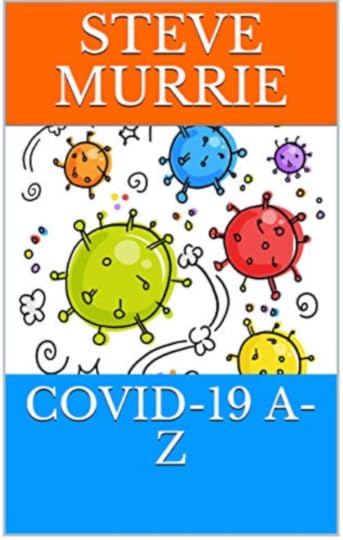
Curiosity Based Learning
What? to Wow!
COVID-19 A-Z
Sustainable Development Goals (SDGs)
May 6, 2020
Manifest Curiosity Part VII:
This post is the first in a series of posts from Manifest Curiosity that details they hows, whens, and whys of Curiosity Based Learning.
What If…? Power Sentence
The What If…? Power Sentence is…
How to write a What If…? Power Sentence: in a minute or less, write a one sentence answer to each of the three questions and then plug them in to the sentence. The What If…? Power Sentence can then be used for anything from students figuring out their topic and thesis, to entrepreneurs communicating their value propositions, to executives developing their strategic plans.
While the writing of each sentence should take no more than a minute in order to discourage self-editing, feel free to prime each question with longer discussions around them before starting the minute to answer.
Step 1: What are you curious about?
Step 2: What are you passionate about?
Step 3: What is something you care enough about to find a solution?
Step 4: Fill in the following sentence with answers from Steps 1-3
What if I combine my curiosity for____ with my passion for_____ to find a solution for_____?
Step 5: What are your next three steps to finding that solution?
Stay Curious with Manifest Curiosity Part VIII: Discovery Learning (a.k.a. Leafy Sea Dragon)

Curiosity Based Learning
What If Hashtags + Platitudes ≠ Appreciation?
What if you give a fraction of the effort appreciating educators they give shaping our future?

Want to appreciate a teacher?
What if educators deserve more than hashtags and platitudes?
What if, the best way to appreciate teachers is to give them the tools and resources they need to help them save their time and make better use of their energy like free access to a Library of Curiosity for educators and learners to access for free and contribute to freely?
What if everyone appreciates a shoutout, even when it's en masse or part of a marketing gimmick that you were tagged in... and asked to perpetuate.
But what if there are some very tangible ways you can appreciate educators?
A few examples of how you can let educators know they're more than a hashtag:
- Write a personal letter to an educator you cherish from your own learning journey.
- Let an educator who works with your child or someone you know that you appreciate the role they play in your life and the health of your community.
- Take greater interest in becoming a more active participant in your child's learning.
- Be diligent in creating an environment at home that helps your child succeed in their environment at school.
- Be curious! Instead of offering hashtags and platitudes, ask educators you know what you could do to better appreciate them as humans and the work they do as professionals.
What if this list is not complete! What if you let me know how I can best appreciate all the educators you know? Let me know and I'll get to doing it.
Curious to hear what other ideas you have to do and share in order to truly appreciate educators for Teacher Appreciation Week and beyond!
Welcome to the Library of Curiosity
What if learning were as easy as curi-osi-ty?

What if the problem with learning is it has the world "learning" right in it. Based on how many have been raised to learn, learning carries connotations of boredom, struggle, and frustration. But what if learning were about celebration, collaboration, and capabilities?
Sure, tons of people talk about the need for more curious learners and more curiosity in our classes, but how many are actually doing anything to make it happen--looking at you, Sir Kenneth Robinson wowing us with big, red paperclips and proclaiming to change the paradigms of education, yet providing zero pathways on how get there and offering even fewer resources for learners and educators killing their own creativity trying.
What if we let curiosity lead our learning?
What if, when we commit to letting curiosity lead our learning, learning becomes an act of discovery, self-fulfillment, and satisfaction?
And what if, with the living Library of Curiosity, you now have pathways, content, and resources at your disposal to make sure all of your learning starts with personal curiosity and follows along pathways fueled by that same curiosity burning from within?
The Library of Curiosity provides free resources to educators, learners, and curious minds with links to lessons, activities, and deep-dives of learning all designed using Curiosity Based Learning.
Every listing in the Library of Curiosity follows a simple structure designed to keep lessons accessible for ages 8-108, yet flexible enough to attach additional learning, activities, or learning approaches at any and all points of discovery.
This is just the start. You can get your start by visiting the Library of Curiosity on this site and following this blog; we'll be updating both regularly with links to lessons, activities, and other resource to learn more, do more, and spread the wonders of what happens when curiosity leads our learning.
Let's get curious together!
Curiosity Based Learning
Library of Curiosity
May 4, 2020
What If the NFL Faces (Temporary) Relocation?
What If Some NFL Teams Will Be Homeless in 2020? Get curious with the President/Founder of SportsFormulator , Matt Fischer about the future of the NFL and sports in 2020 and beyond.
The 2020 NFL schedule will be released this week and with so much uncertainty due to COVID-19, we don’t know if games will be played in stadiums with fans or not. All we do know, is the NFL is moving forward and planning to play a full 17 week regular season.
With certain states seeming to look like they may not open in time for the start of the 2020 NFL season in September, it’s time to create contingencies as we are looking at potentially a handful of homeless NFL teams.
I’m looking into my crystal ball and think most states will be back open by September except for New York, New Jersey and California. This leaves five NFL teams potentially homeless.
2020 NFL Homeless Teams
These are teams that could play a full season on the road. The Los Angeles Rams, Los Angeles Chargers, San Francisco 49ers, New York Jets and New York Giants will all need a new place to play.
Well good news, I’ve got a solution for this temporary problem.
Let’s first bring football back to St. Louis. While fans still have a sour taste in their mouth from the Rams leaving, they won’t be able to attend games so the NFL doesn’t have to risk have poor attendance as I don’t think fans will be in any stadiums this fall.
With the Edward Jones Dome, it’ll be easier to have two teams play there, as you don’t have to worry about the wear and tear a natural grass field would have so I’m looking at that for all of our NFL relocations.
Let’s put the Giants and Chargers in St. Louis for 2020. They’re still the New York Giants and Los Angeles Rams but will play their home games in St. Louis.
The Rams were to open up their new stadium this fall but it’ll sit empty. Let’s get the Rams the NFL’s newest stadium and put them with the Raiders in Las Vegas.
The reigning NFC Champion San Francisco 49ers need a place to call home this fall. Let’s send them to Jerry World in Dallas. The 49ers are supposed to play there this season anyway so they get one road game at their new home stadium.
The Jets are the most challenging relocation team. The division is spread out with Buffalo, New England and Miami. I’m putting the Jets in Miami. Baltimore will be a good team to have on Monday night at least a couple times this season and with field turf, we can have back-to-back games.
2020 NFL relocation:
-Los Angeles Chargers in St. Louis
-Los Angeles Rams in Dallas
-New York Giants in St. Louis
-New York Jets in Baltimore
-San Francisco 49ers in Las Vegas
There are a lot of unknowns ahead for all of us but hopefully football is back this fall wherever it may be played.
May 1, 2020
Curious About Kindness
Let your curiosity lead you’re learning as you explore and discover more about what altruism is, if exists, and whether it’s possible to exist at all with this curiosity based learning activity and reading from The Book of What If...?
https://www.youtube.com/watch?v=mpFNrdKXRl0&feature=youtu.be
Question: #WhatIf society we’re truly altruistic?
Activity: Become a Secret Servant Agent. Spend an entire day doing nice things for other people (for example, make your sibling's bed, do the dishes, rake your neighbor's leaves, write a letter telling someone how awesome he or she is, etc.) but do them without anyone seeing you or knowing it was you. Can you be stealthy enough not to get caught? If you can, how do you feel after doing these things that were kind to someone else but gave you nothing in return?
Keep in Mind: Not everyone believes altruism exists or can exist; you might be one of those people. That's 100% ok! This activity should help you better understand altruism, whether it's possible, and if so, how it might work. Whether you think altruism is possible or impossible, keep an open mind during your time as a Secret Servant Agent so you can have evidence to support your opinion.
Deeper Learning: Are humans the only animals capable (or incapable) of altruism? See what you can discover in the plant and animal worlds about examples of plants or animals behaving altruistically. What can humans learn from you find?
Challenge: How many other people can you convince to become a Secret Servant Agent for a day? How would you go about convincing them to take time and make sacrifices for doing things for which they will receive no recognition or reward?

Curiosity Based Learning
Curiosity Q&A
The Book of What If...?
Mental Health Awareness



